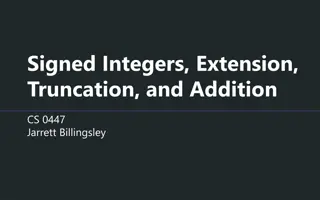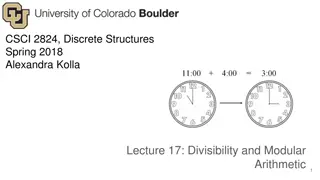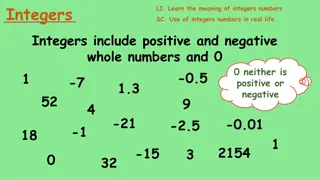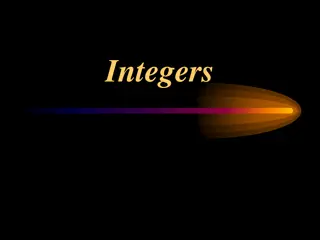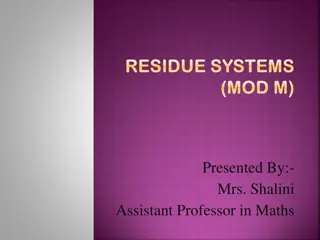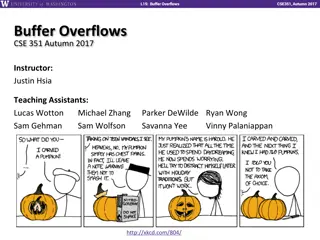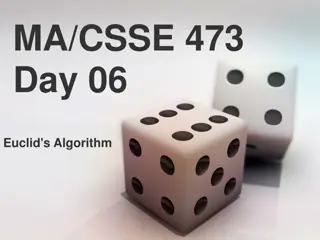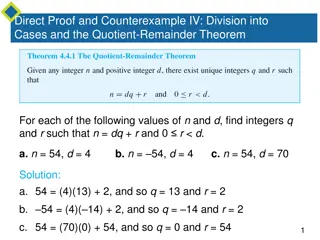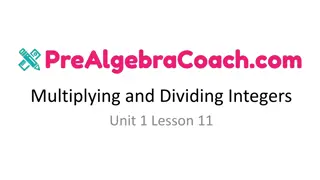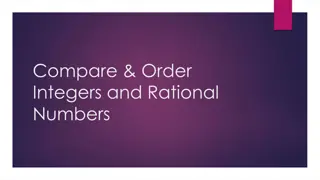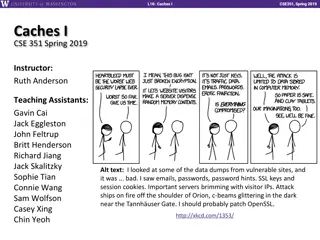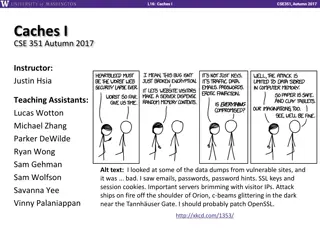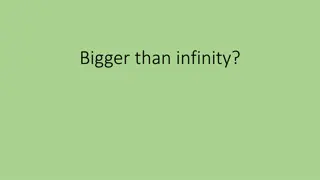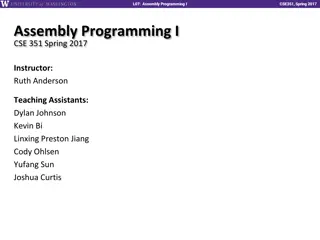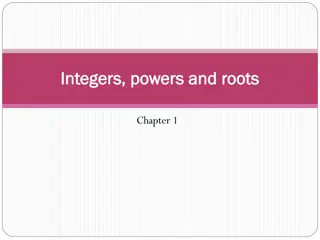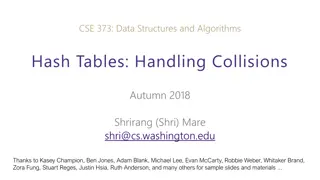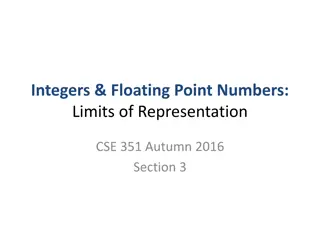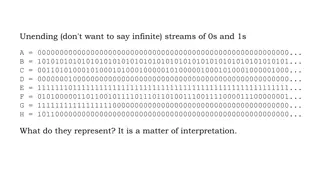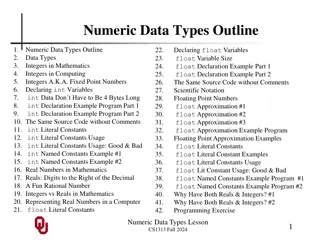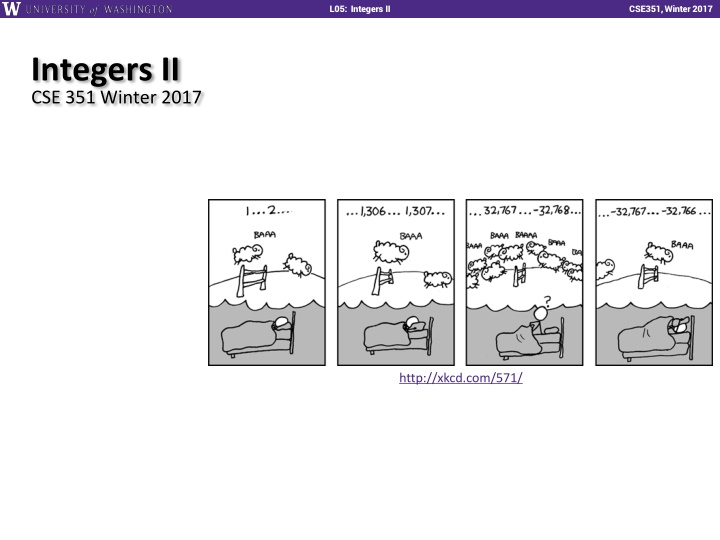
Understanding Binary Integer Representations in Computer Systems
Explore the binary representation of integers in computer systems, including signed and unsigned formats, sign and magnitude encoding, limitations of finite width representations, overflow, sign extension, shifting, and arithmetic operations. Delve into practical examples and the implications for hardware and programming languages like C.
Download Presentation

Please find below an Image/Link to download the presentation.
The content on the website is provided AS IS for your information and personal use only. It may not be sold, licensed, or shared on other websites without obtaining consent from the author. If you encounter any issues during the download, it is possible that the publisher has removed the file from their server.
You are allowed to download the files provided on this website for personal or commercial use, subject to the condition that they are used lawfully. All files are the property of their respective owners.
The content on the website is provided AS IS for your information and personal use only. It may not be sold, licensed, or shared on other websites without obtaining consent from the author.
E N D
Presentation Transcript
L01: Intro, Combinational Logic L05: Integers II CSE369, Autumn 2016 CSE351, Winter 2017 Integers II CSE 351 Winter 2017 http://xkcd.com/571/
L01: Intro, Combinational Logic L05: Integers II CSE369, Autumn 2016 CSE351, Winter 2017 Administrivia No class Monday: After today, Lab 1 should be easy 2
L01: Intro, Combinational Logic L05: Integers II CSE369, Autumn 2016 CSE351, Winter 2017 Integers Binary representation of integers Unsigned and signed Casting in C Consequences of finite width representations Overflow, sign extension Shifting and arithmetic operations 3
L01: Intro, Combinational Logic L05: Integers II CSE369, Autumn 2016 CSE351, Winter 2017 Encoding Integers The hardware (and C) supports two flavors of integers unsigned only the non-negatives signed both negatives and non-negatives Cannot represent all integers with ? bits Only 2? distinct bit patterns Unsigned values: Signed values: 2? 1 2? 1 1 0 ... 2? 1 Example: 8-bit integers (i.e., char) - + 128 ?? ? 0 ? +128 +?? ? +256 +?? 4
L01: Intro, Combinational Logic L05: Integers II CSE369, Autumn 2016 CSE351, Winter 2017 Sign and Magnitude Most Significant Bit Designate the high-order bit (MSB) as the sign bit sign=0: positive numbers; sign=1: negative numbers Positives: Using MSB as sign bit matches positive numbers with unsigned All zeros encoding is still = 0 Examples (8 bits): 0x00 = 000000002 is non-negative, because the sign bit is 0 0x7F = 011111112 is non-negative (+12710) 0x85 = 100001012 is negative (-510) 0x80 = 100000002 is negative... ... zero??? 5
L01: Intro, Combinational Logic L05: Integers II CSE369, Autumn 2016 CSE351, Winter 2017 Sign and Magnitude MSB is the sign bit, rest of the bits are magnitude Drawbacks? 7 + 0 15 0 6 + 1 14 1 1111 0000 1111 0000 1110 0001 1110 0001 5 + 2 13 2 1101 0010 1101 0010 4 + 3 12 3 1100 0011 1100 0011 Sign and Magnitude Unsigned 1011 0100 1011 0100 3 + 4 11 4 1010 0101 1010 0101 2 + 5 10 5 1001 0110 1001 0110 1000 0111 1000 0111 1 + 6 9 6 0 + 7 8 7 6
L01: Intro, Combinational Logic L05: Integers II CSE369, Autumn 2016 CSE351, Winter 2017 Sign and Magnitude MSB is the sign bit, rest of the bits are magnitude Drawbacks: Two representations of 0 (bad for checking equality) 7 + 0 6 + 1 1111 0000 1110 0001 5 + 2 1101 0010 4 + 3 1100 0011 Sign and Magnitude 1011 0100 3 + 4 1010 0101 2 + 5 1001 0110 1000 0111 1 + 6 0 + 7 7
L01: Intro, Combinational Logic L05: Integers II CSE369, Autumn 2016 CSE351, Winter 2017 Sign and Magnitude MSB is the sign bit, rest of the bits are magnitude Drawbacks: Two representations of 0 (bad for checking equality) Arithmetic is cumbersome Example: 4-3 != 4+(-3) 7 + 0 6 + 1 1111 0000 1110 0001 5 + 2 1101 0010 4 0100 - 0011 0001 4 0100 + 1011 1111 4 + 3 1100 0011 - 3 1 + -3 -7 Sign and Magnitude 1011 0100 3 + 4 1010 0101 Negatives increment in wrong direction! 2 + 5 1001 0110 1000 0111 1 + 6 0 + 7 8
L01: Intro, Combinational Logic L05: Integers II CSE369, Autumn 2016 CSE351, Winter 2017 Two s Complement Let s fix these problems: 1) Flip negative encodings so incrementing works 7 + 0 0 + 0 6 + 1 1 + 1 1111 0000 1111 0000 1110 0001 1110 0001 5 + 2 2 + 2 1101 0010 1101 0010 4 + 3 3 + 3 1100 0011 1100 0011 Sign and Magnitude Two s Complement 1011 0100 1011 0100 3 + 4 4 + 4 1010 0101 1010 0101 2 + 5 5 + 5 1001 0110 1001 0110 1000 0111 1000 0111 1 + 6 6 + 6 0 + 7 7 + 7 9
L01: Intro, Combinational Logic L05: Integers II CSE369, Autumn 2016 CSE351, Winter 2017 Two s Complement Let s fix these problems: 1) Flip negative encodings so incrementing works 2) Shift negative numbers to eliminate 0 1 + 0 2 + 1 1111 0000 MSB still indicates sign! 1110 0001 3 + 2 1101 0010 4 + 3 1100 0011 1011 0100 5 + 4 1010 0101 6 + 5 1001 0110 1000 0111 7 + 6 8 + 7 10
L01: Intro, Combinational Logic L05: Integers II CSE369, Autumn 2016 CSE351, Winter 2017 Two s Complement Negatives Accomplished with one neat mathematical trick! bw 1 has weight 2w 1, other bits have usual weights +2i bw-1 bw-2 . . . b0 4-bit Examples: 1 + 0 2 + 1 10102 unsigned: 1*23+0*22+1*21+0*20 = 10 1111 0000 1110 0001 3 + 2 1101 0010 10102two s complement: -1*23+0*22+1*21+0*20 = 6 4 + 3 1100 0011 Two s Complement -1 represented as: 11112 = -23+(23 1) MSB makes it super negative, add up all the other bits to get back up to -1 1011 0100 5 + 4 1010 0101 6 + 5 1001 0110 1000 0111 7 + 6 8 + 7 11
L01: Intro, Combinational Logic L05: Integers II CSE369, Autumn 2016 CSE351, Winter 2017 Why Two s Complement is So Great Roughly same number of (+) and ( ) numbers Positive number encodings match unsigned Single zero All zeros encoding = 0 1 + 0 2 + 1 1111 0000 1110 0001 3 + 2 Simple negation procedure: Get negative representation of any integer by taking bitwise complement and then adding one! ( ~x + 1 == -x ) 1101 0010 4 + 3 1100 0011 Two s Complement 1011 0100 5 + 4 1010 0101 6 + 5 1001 0110 1000 0111 7 + 6 8 + 7 12
L01: Intro, Combinational Logic L05: Integers II CSE369, Autumn 2016 CSE351, Winter 2017 Unsigned vs. Two s Complement 1011 4-bit Example: Unsigned Two s Complement 1x23 + 0x22 + 1x21 + 1x20 1x(-23) + 0x22 + 1x21 + 1x20 11 -5 (math) difference = 16 = 24 1 0 15 0 2 + 1 14 1 1111 0000 1111 0000 1110 0001 1110 0001 3 + 2 13 2 1101 0010 1101 0010 4 + 3 12 3 1100 0011 1100 0011 Two s Unsigned Complement 1011 0100 1011 0100 5 + 4 11 4 1010 0101 1010 0101 6 + 5 10 5 1001 0110 1001 0110 1000 0111 1000 0111 7 + 6 9 6 8 + 7 8 7 13
L01: Intro, Combinational Logic L05: Integers II CSE369, Autumn 2016 CSE351, Winter 2017 Unsigned vs. Two s Complement 1011 4-bit Example: Unsigned Two s Complement 1x23 + 0x22 + 1x21 + 1x20 1x(-23) + 0x22 + 1x21 + 1x20 11 -5 (math) difference = 16 = 24 1 0 15 0 2 + 1 14 1 1111 0000 1111 0000 1110 0001 1110 0001 3 + 2 13 2 1101 0010 1101 0010 4 + 3 12 3 1100 0011 1100 0011 Two s Unsigned Complement 1011 0100 1011 0100 5 + 4 11 4 1010 0101 1010 0101 6 + 5 10 5 1001 0110 1001 0110 1000 0111 1000 0111 7 + 6 9 6 8 + 7 8 7 14
L01: Intro, Combinational Logic L05: Integers II CSE369, Autumn 2016 CSE351, Winter 2017 Two s Complement Arithmetic The same addition procedure works for both unsigned and two s complement integers Simplifies hardware: only one algorithm for addition Algorithm: simple addition, discard the highest carry bit Called modular addition: result is sum modulo2? 4-bit Examples: 4 0100 +0011 =0111 -4 +3 =-1 1100 +0011 =1111 4 0100 +1101 10001 =0001 +3 =7 -3 =1 15
L01: Intro, Combinational Logic L05: Integers II CSE369, Autumn 2016 CSE351, Winter 2017 Why Does Two s Complement Work? For all representable positive integers ?, we want: bit representation of ? +bit representation of ? (ignoring the carry-out bit) 0 What are the 8-bit negative encodings for the following? 00000001 + ???????? 00000000 00000010 + ???????? 00000000 11000011 + ???????? 00000000 16
L01: Intro, Combinational Logic L05: Integers II CSE369, Autumn 2016 CSE351, Winter 2017 Why Does Two s Complement Work? For all representable positive integers ?, we want: bit representation of ? +bit representation of ? (ignoring the carry-out bit) 0 What are the 8-bit negative encodings for the following? 00000001 + 11111111 100000000 00000010 + 11111110 100000000 11000011 + 00111101 100000000 These are the bitwise complement plus 1! -x == ~x + 1 17
L01: Intro, Combinational Logic L05: Integers II CSE369, Autumn 2016 CSE351, Winter 2017 Signed/Unsigned Conversion Visualized Two s Complement Unsigned Ordering Inversion Negative Big Positive UMax UMax 1 TMax + 1 Unsigned Range TMax TMax 2 s Complement 0 0 Range 1 2 TMin 18
L01: Intro, Combinational Logic L05: Integers II CSE369, Autumn 2016 CSE351, Winter 2017 Values To Remember Unsigned Values UMin UMax Two s Complement Values TMin = = TMax = = 1 = 0b00 0 0 0b10 0 2? 1 = = 0b11 1 2? 1 0b01 1 2? 1 1 = = 0b11 1 Example: Values for ? = 32 Decimal Hex Binary FF FF FF FF 11111111 11111111 11111111 11111111 UMax 4,294,967,296 7F FF FF FF 01111111 11111111 11111111 11111111 TMax 2,147,483,647 80 00 00 00 FF FF FF FF 00 00 00 00 10000000 00000000 00000000 00000000 11111111 11111111 11111111 11111111 00000000 00000000 00000000 00000000 TMin -2,147,483,648 -1 -1 0 0 19
L01: Intro, Combinational Logic L05: Integers II CSE369, Autumn 2016 CSE351, Winter 2017 In C: Signed vs. Unsigned Casting Bits are unchanged, just interpreted differently! int tx, ty; unsigned ux, uy; Explicit casting tx = (int) ux; uy = (unsigned) ty; Implicit casting can occur during assignments or function calls tx = ux; uy = ty; gcc flag -Wsign-conversion produces warnings for implicit casts, but -Wall does not 20
L01: Intro, Combinational Logic L05: Integers II CSE369, Autumn 2016 CSE351, Winter 2017 !!! Casting Surprises Integer literals (constants) By default, integer constants are considered signed integers Hex constants already have an explicit binary representation Use U (or u ) suffix to explicitly force unsigned Examples: 0U, 4294967259u Expression Evaluation When you mixed unsigned and signed in a single expression, then signed values are implicitly cast to unsigned Including comparison operators <, >, ==, <=, >= 21
L01: Intro, Combinational Logic L05: Integers II CSE369, Autumn 2016 CSE351, Winter 2017 !!! Casting Surprises 32-bit examples: TMin = -2,147,483,648, TMax = 2,147,483,647 Left Constant 0 0000 0000 0000 0000 0000 0000 0000 0000 -1 1111 1111 1111 1111 1111 1111 1111 1111 -1 1111 1111 1111 1111 1111 1111 1111 1111 2147483647 0111 1111 1111 1111 1111 1111 1111 1111 2147483647U 0111 1111 1111 1111 1111 1111 1111 1111 -1 1111 1111 1111 1111 1111 1111 1111 1111 (unsigned) -1 1111 1111 1111 1111 1111 1111 1111 1111 2147483647 0111 1111 1111 1111 1111 1111 1111 1111 2147483647 0111 1111 1111 1111 1111 1111 1111 1111 Right Constant 0U 0000 0000 0000 0000 0000 0000 0000 0000 0 0000 0000 0000 0000 0000 0000 0000 0000 0U 0000 0000 0000 0000 0000 0000 0000 0000 -2147483648 1000 0000 0000 0000 0000 0000 0000 0000 -2147483648 1000 0000 0000 0000 0000 0000 0000 0000 -2 1111 1111 1111 1111 1111 1111 1111 1110 -2 1111 1111 1111 1111 1111 1111 1111 1110 2147483648U 1000 0000 0000 0000 0000 0000 0000 0000 (int) 2147483648U 1000 0000 0000 0000 0000 0000 0000 0000 Op Interpretation == Unsigned < Signed > Unsigned > Signed < Unsigned > Signed > Unsigned < Unsigned > Signed 22
L01: Intro, Combinational Logic L05: Integers II CSE369, Autumn 2016 CSE351, Winter 2017 Integers Binary representation of integers Unsigned and signed Casting in C Consequences of finite width representations Overflow, sign extension Shifting and arithmetic operations 23
L01: Intro, Combinational Logic L05: Integers II CSE369, Autumn 2016 CSE351, Winter 2017 Arithmetic Overflow Bits 0000 0001 0010 0011 0100 0101 0110 0111 1000 1001 1010 1011 1100 1101 1110 1111 Unsigned Signed 0 1 2 3 4 5 6 7 8 9 10 11 12 13 14 15 When a calculation produces a result that can t be represented in the current encoding scheme Integer range limited by fixed width Can occur in both the positive and negative directions 0 1 2 3 4 5 6 7 -8 -7 -6 -5 -4 -3 -2 -1 Computer handling of overflow CPU may be capable of throwing an exception for overflow on signed values CPU doesn t throw exception for unsigned C and Java ignore overflow exceptions oops! 24
L01: Intro, Combinational Logic L05: Integers II CSE369, Autumn 2016 CSE351, Winter 2017 Overflow: Unsigned Addition: drop carry bit ( 2N) 15 + 2 17 1 1111 + 0010 10001 15 0 14 1 1111 0000 1110 0001 13 2 1101 0010 12 3 1100 0011 Subtraction: borrow (+2N) 1 - 2 -1 15 Unsigned 1011 0100 11 4 10001 - 0010 1111 1010 0101 10 5 1001 0110 1000 0111 9 6 8 7 2N because of modular arithmetic 25
L01: Intro, Combinational Logic L05: Integers II CSE369, Autumn 2016 CSE351, Winter 2017 Overflow: Two s Complement Addition: (+) + (+) = ( ) result? 6 + 3 9 -7 0110 + 0011 1001 1 0 2 + 1 1111 0000 1110 0001 3 + 2 1101 0010 4 + 3 1100 0011 Two s Subtraction: ( ) + ( ) = (+)? -7 - 3 -10 6 Complement 1011 0100 5 + 4 1001 - 0011 0110 1010 0101 6 + 5 1001 0110 1000 0111 7 + 6 8 + 7 For signed: overflow if operands have same sign and result s sign is different 26
L01: Intro, Combinational Logic L05: Integers II CSE369, Autumn 2016 CSE351, Winter 2017 Sign Extension What happens if you convert a signed integral data type to a larger one? e.g., char short int long 4-bit 8-bit Example: Positive Case 0010 4-bit: = +2 Add 0 s? ????0010 00000010 8-bit: = +2 ? 27
L01: Intro, Combinational Logic L05: Integers II CSE369, Autumn 2016 CSE351, Winter 2017 Sign Extension What happens if you convert a signed integral data type to a larger one? e.g., char short int long 4-bit 8-bit Example: Positive Case 0010 4-bit: = +2 Add 0 s? 00000010 8-bit: = +2 1100 Negative Case 4-bit: 8-bit: = = -4 ? +12 ????1100 00001100 10001100 11111100 Add 0 s? = -116 ? Make MSB 1? = ? -4 Add 1 s? 28
L01: Intro, Combinational Logic L05: Integers II CSE369, Autumn 2016 CSE351, Winter 2017 Sign Extension Task: Given a ?-bit signed integer X, convert it to ?+?-bit signed integer X with the same value Rule: Add ? copies of sign bit Let ?? be the ?-th digit of X in binary X = ?? 1, ,?? 1,?? 1,?? 2, ,?1,?0 ? copies of MSB original X ? X X ? ? 29
L01: Intro, Combinational Logic L05: Integers II CSE369, Autumn 2016 CSE351, Winter 2017 Sign Extension Example Convert from smaller to larger integral data types C automatically performs sign extension Java too short int x = 12345; int ix = (int) x; short int y = -12345; int iy = (int) y; Var x ix y iy Decimal 12345 12345 -12345 -12345 Hex Binary 30 39 00110000 00111001 00 00 30 39 00000000 00000000 00110000 00111001 CF C7 11001111 11000111 FF FF CF C7 11111111 11111111 11001111 11000111 30
L01: Intro, Combinational Logic L05: Integers II CSE369, Autumn 2016 CSE351, Winter 2017 Integers Binary representation of integers Unsigned and signed Casting in C Consequences of finite width representations Overflow, sign extension Shifting and arithmetic operations 31
L01: Intro, Combinational Logic L05: Integers II CSE369, Autumn 2016 CSE351, Winter 2017 Shift Operations Left shift (x<<n) bit vector x by n positions Throw away (drop) extra bits on left Fill with 0s on right Right shift (x>>n) bit-vector x by n positions Throw away (drop) extra bits on right Logical shift (for unsigned values) Fill with 0s on left Arithmetic shift (for signed values) Replicate most significant bit on left Maintains sign of x 32
L01: Intro, Combinational Logic L05: Integers II CSE369, Autumn 2016 CSE351, Winter 2017 Shift Operations x 0010 0010 x<<3 0001 0000 Left shift (x<<n) Fill with 0s on right logical: x>>2 0000 1000 arithmetic: x>>2 0000 1000 Right shift (x>>n) Logical shift (for unsigned values) x 1010 0010 x<<3 0001 0000 Fill with 0s on left Arithmetic shift (for signed values) logical: x>>2 0010 1000 arithmetic: x>>2 1110 1000 Replicate most significant bit on left Notes: Shifts by n<0 or n w (bit width of x) are undefined In C: behavior of >> is determined by compiler In gcc / C lang, depends on data type of x (signed/unsigned) In Java: logical shift is >>> and arithmetic shift is >> 33
L01: Intro, Combinational Logic L05: Integers II CSE369, Autumn 2016 CSE351, Winter 2017 Shifting Arithmetic? What are the following computing? x>>n 0b 0100 >> 1 = 0b 0010 0b 0100 >> 2 = 0b 0001 Divide by 2n x<<n 0b 0001 << 1 = 0b 0010 0b 0001 << 2 = 0b 0100 Multiply by 2n Shifting is faster than general multiply and divide operations 34
L01: Intro, Combinational Logic L05: Integers II CSE369, Autumn 2016 CSE351, Winter 2017 Left Shifting Arithmetic 8-bit Example No difference in left shift operation for unsigned and signed numbers (just manipulates bits) Difference comes during interpretation: x*2n? Signed Unsigned x = 25; 00011001 = 25 25 L1=x<<2; 0001100100 = 100 100 L2=x<<3; 00011001000 = -56 200 signed overflow signed overflow L3=x<<4; 000110010000 = -112 144 unsigned overflow 35
L01: Intro, Combinational Logic L05: Integers II CSE369, Autumn 2016 CSE351, Winter 2017 Right Shifting Arithmetic 8-bit Examples Reminder: C operator >> does logical shift on unsigned values and arithmetic shift on signed values Logical Shift: x/2n? xu = 240u; 11110000 = 240 R1u=xu>>3; 00011110000 = 30 R2u=xu>>5; 0000011110000 = 7 rounding (down) 36
L01: Intro, Combinational Logic L05: Integers II CSE369, Autumn 2016 CSE351, Winter 2017 Right Shifting Arithmetic 8-bit Examples Reminder: C operator >> does logical shift on unsigned values and arithmetic shift on signed values Arithmetic Shift: x/2n? xs = -16; 11110000 = -16 R1s=xu>>3; 11111110000 = -2 R2s=xu>>5; 1111111110000 = -1 rounding (down) 37
L01: Intro, Combinational Logic L05: Integers II CSE369, Autumn 2016 CSE351, Winter 2017 Peer Instruction Question For the following expressions, find a value of char x, if there exists one, that makes the expression TRUE. Compare with your neighbor(s)! Assume we are using 8-bit arithmetic: x == (unsigned char) x x >= 128U x != (x>>2)<<2 x == -x Hint: there are two solutions (x < 128U) && (x > 0x3F) 38
L01: Intro, Combinational Logic L05: Integers II CSE369, Autumn 2016 CSE351, Winter 2017 Using Shifts and Masks Extract the 2nd most significant byte of an int: First shift, then mask: (x>>16) & 0xFF x 00000001 00000010 00000011 00000100 x>>16 00000000 00000000 00000001 00000010 00000000 00000000 00000000 11111111 (x>>16) & 0xFF 00000000 00000000 00000000 00000010 0xFF 39
L01: Intro, Combinational Logic L05: Integers II CSE369, Autumn 2016 CSE351, Winter 2017 Using Shifts and Masks Extract the sign bit of a signed int: First shift, then mask: (x>>31) & 0x1 Assuming arithmetic shift here, but works in either case Need mask to clear 1s possibly shifted in 0 x 00000001 00000010 00000011 00000100 00000000 00000000 00000000 00000000 00000000 00000000 00000000 00000001 00000000 00000000 00000000 00000000 x>>31 0x1 0 (x>>31) & 0x1 1 x 10000001 00000010 00000011 00000100 11111111 11111111 11111111 11111111 00000000 00000000 00000000 00000001 00000000 00000000 00000000 00000001 1 x>>31 0x1 (x>>31) & 0x1 40
L01: Intro, Combinational Logic L05: Integers II CSE369, Autumn 2016 CSE351, Winter 2017 Using Shifts and Masks Conditionals as Boolean expressions For int x, what does (x<<31)>>31 do? x=!!123 x<<31 (x<<31)>>31 !x !x<<31 (!x<<31)>>31 00000000 00000000 00000000 00000001 10000000 00000000 00000000 00000000 11111111 11111111 11111111 11111111 00000000 00000000 00000000 00000000 00000000 00000000 00000000 00000000 00000000 00000000 00000000 00000000 Can use in place of conditional: In C: if(x) {a=y;} else {a=z;} equivalent to a=x?y:z; a=(((x<<31)>>31)&y) | (((!x<<31)>>31)&z); 41
L01: Intro, Combinational Logic L05: Integers II CSE369, Autumn 2016 CSE351, Winter 2017 Summary Sign and unsigned variables in C Bit pattern remains the same, just interpret differently Strange things can happen with our arithmetic when we convert/cast between sign and unsigned numbers Type of variables affects behavior of operators (shifting, comparison) We can only represent so many numbers in ? bits When we exceed the limits, arithmetic overflow occurs Sign extension tries to preserve value when expanding Shifting is a useful bitwise operator Can be used in multiplication with constant or bit masking Right shifting can be arithmetic (sign) or logical (0) 42

